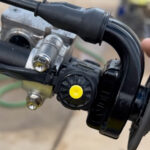Welcome to Morning Espresso, an awesome piece presented by MotoSport.com. Go check out RDRCO (pronounced “rider-co”) as the company’s exclusive riding gear. This new gear line offers an affordable option for weekend riders and the casual racer.
Meet Daniel Blair, a seasoned and retired professional racer, who also spent time covering the sport as a broadcast journalist. Today you can find him trackside at many races throughout the season managing the Orange Brigade, GasGas Mob, and Team Husqvarna amateur teams.
Let’s face it, you know who DB is. You’re familiar with his game. You also trust his judgement and respect what he says because he’s an analyst of the sport, but he’s always been fair and balanced.
Today the topic of conversation with Blair, is about the State of Racing in amateur motocross. Is racing locally important? How can we change the mantra that it isn’t important anymore? Let’s hear an opinion from someone who started racing at five and spent his entire life at tracks then shall we?
“I spent most of my youth driving down to southern California finding kids to race at Perris, Glen Helen, Sunrise and all of those tracks,” said Blair. “Racing and gate drops are more important than anything because it’s the real test. You can ride, practice, and develop your skills, train…you can do that all you want. But, until you go on a gate with a bunch of other kids that are all prepared like you are and put that to a test, you really don’t know where you’re at or how good you really are.”
Today, training facilities have taken over. Big time amateur kids are staying at those facilities and only racing a handful of times per year. They aren’t traveling and hitting up the local Chicken Licks Raceways anymore like they used to.
It used to be that you raced every weekend. That’s what guys like Jeff Emig, Zach Osborne, Cooper Webb, and many other champions have done in their amateur careers. And that doesn’t even scratch the surface of names! Somewhere along the way that stopped. Blair thinks that you need to race weekly to develop a fine tuned race craft.
“You need to race. You need to race all the time, as much as possible, and if you’re at a training facility that’s good you have better access during the week to work on the things that you should be finding out on the weekends,” Blair said. “You can practice and train all you want, but until you take it to the race track for a test, you really don’t know.”
Gate drops, no matter what level, teach you lessons. You never know which racing situation as an amateur is going to teach you something that you can use when you’re battling for position at a Monster Energy Supercross or Pro Motocross National down the road. You can practice all you want during the week, but until you have that intensity of a race day it may not do you any favors.
“As long as things are rolling and you’re healthy you should be racing every single weekend because those gate drops simulate the reality of what you’re going to face when you go to a big race, or if you go to a Supercross one day, so gate drops, gate drops, gate drops,” Blair said.
Today it seems like amateurs are trying to not show their cards when camped out in training facilities. They don’t want their competition to know what they’re working on, or if they got faster, but the thing is can they translate that over to racing?
“I think it’s very important that riders are always racing locally in situations where they can be successful, but also finding races that are bigger with more competition where you do lose and you get whooped up sometimes,” Blair said. “That’s where you’ll get your best lessons.”
Essentially, Blair thinks that the more racing experience you have then the better you’ll be in the longevity of your career. He preaches this to the Austrian group’s amateur athletes.
“The reality of the gap between the kid that’s winning locally and the kid that’s winning nationally it’s not at big as you think,” Blair said. “It’s mostly in the head, it’s in experience, it’s in confidence. The more you do those types of races and get your feet wet, get a little better, get a little better, that gap that a rider naturally has between local and national racing closes. It always closes with experience.”
Last but not least, racing leads to expectations. Most kids trying to make a go at a professional career will look incredible on a practice track. Yet, at the same time, that’s just practice, so no one is really going to be that upset if you blow a berm out or make small mistakes. Blair thinks that racing is the way to thrive under the pressure of expectance.
“It’s a pressure thing when you’re racing their is an expected outcome so there is a lot of pressure on meeting that expectation,” Blair said. “When you’re practicing you’re not being judged as much. You’re just going through the motions like a lot of people do. A wise man once told me that you can’t measure without a measurement and that happens at the race track plain and simple.”
Main Image: Courtesy of Daniel Blair






